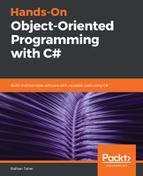If you have any exposure to web development, you might have heard of ASP.NET, which is a framework for web development. Similarly, if you have worked with databases before in .NET projects, you should have heard of or used ADO.NET. ADO.NET is a framework that's similar to ASP.NET, but instead of web development, this framework is used for database-related work. An ActiveX Data Object (ADO) was an old technology created by Microsoft, but the evolution to ADO.NET has been extraordinary. ADO.NET contains classes and methods that can be used to easily establish a connection with a database-management system such as SQL Server or Oracle. Not only that, it also provides methods and objects that help to execute commands in the database, such as select, insert, update, and delete.
We need a separate framework for the database connection and activity because there are a lot of different database systems that can be used when developing an application. Databases are a very important part of an application; applications need data and data needs to be stored in a database. Because databases are so important and there are so many databases available, it would be very hard for a developer to write all the necessary code. It's not worth writing separate bits of code when we could write one piece of code that is reusable. This is why Microsoft came up with this ADO.NET framework. This framework has different data providers, datasets, data adapters, and various other things that are related to databases.
This chapter will cover the following topics:
- The fundamentals of ADO.NET
- DataProviders, Connection, Command, DataReader, and DataAdapter
- Connecting SQL Server Database and the Oracle Database
- Stored Procedures
- Entity Frameworks
- Transactions in SQL
